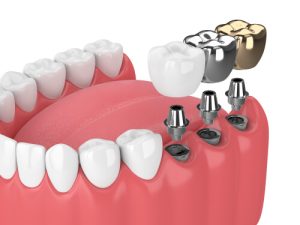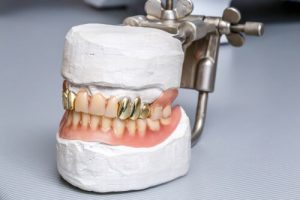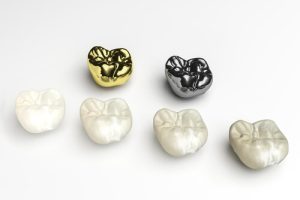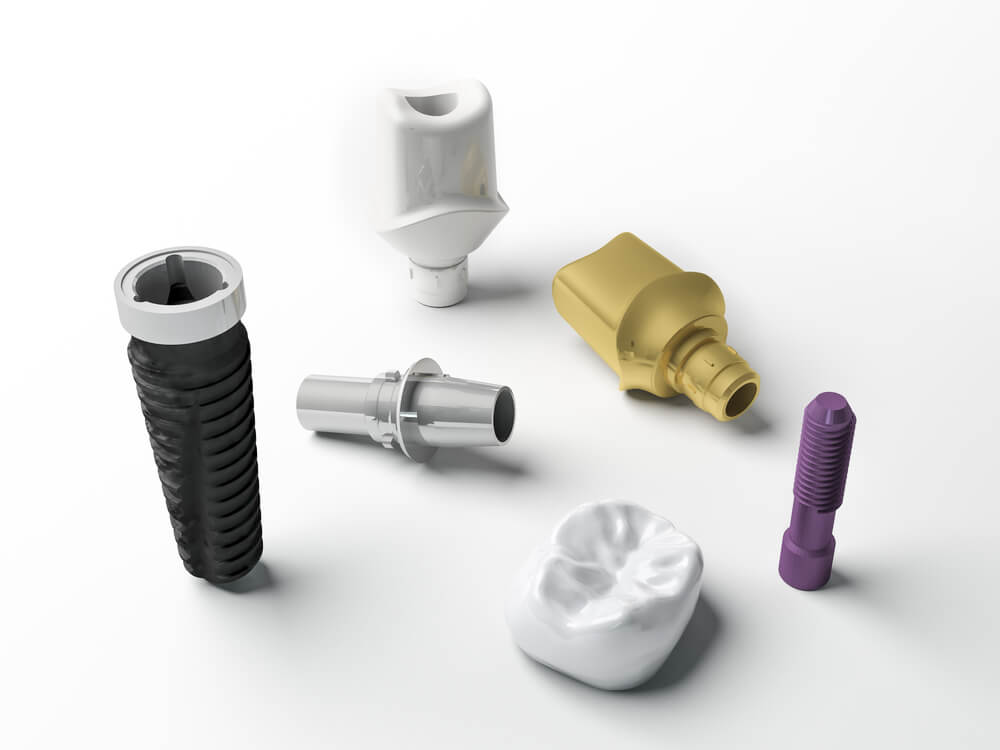Using gold teeth is not something new. Traditionally, this metal was used to replace missing teeth, fill cavities, and used as gold crowns, since it is a biocompatible material that the body and tissue wouldn’t reject. And it will come as no surprise that some may also think of gold dental implants, and they’re becoming an increasingly popular option for tooth replacement. However, some dental experts do not take these into consideration long-term consequences. And currently, most dentists don’t use or recommend gold teeth implants, especially because we now have better materials that are lighter, biocompatible, and cheaper.
Through all these, some still opt for gold dental implants. But what exactly does it entail? Here’s a look at the pros and cons of gold dental implants, so you can make an informed decision regarding your oral surgery.
Gold in dentistry
Are there different types of gold teeth? Yes! Let’s have a look at them now:
- Gold grills: You probably know about grills for cars, but what are grills for teeth? These are decorative covers that snap over one or more teeth. These can be encrusted with jewels and precious metals and are generally removable.
- Gold tooth crown: Also known as tooth caps, some people will have their teeth fitted with gold crowns for a permanent golden fix. These are custom-fitted coverings to replace the natural crown of your tooth by using gold instead of another material.
- Gold braces: Though not exactly a tooth replacement, gold braces are a lavish alternative to traditional braces.
- Gold tooth filling: Although this option isn’t very common nowadays, a gold tooth filling is still an option in modern dentistry. Most fillings are in places that aren’t visible when you smile normally, so the point of this is less aesthetic and more a personal preference.
- Gold tooth implant: These teeth are not 100% gold since it is too soft to be used on their own as a tooth replacement. Gold teeth implants are usually 20-70% gold alloy; the only golden part is actually the crown. The metals usually mixed with gold for the alloy implant are copper, platinum, zinc, or silver. An implant will replace the root of your tooth with a metal screw, and a socket is put into the jawbone to hold it in place.
Gold tooth crowns and implants: Advantages and Disadvantages
Pros
 Gold is malleable, very durable, and resistant to wear and tear. This makes gold dental implants more reliable than other materials when it comes to durability and longevity.
Gold is malleable, very durable, and resistant to wear and tear. This makes gold dental implants more reliable than other materials when it comes to durability and longevity.- Gold is also very biocompatible, which means it won’t cause any allergies or sensitivities in patients. Your body won’t reject the metal from your body like it would other foreign objects.
- Gold dental implants are also aesthetically pleasing since they have a luxurious golden appearance that looks great when matched with other metals or porcelain teeth.
- Unlike other metal materials, gold is radiopaque, which means that it shows up better on x-rays than alloys or some plastic materials. This makes diagnosis easier for the dentist.
- Gold has historically been a symbol of wealth, so this type of implant may appeal to those looking to invest in their health uniquely!
Cons
- One of the biggest drawbacks to using gold dental implants is the cost – they tend to be more expensive than other materials due to the price of raw gold itself.
- Some dentists may be reluctant to use gold due to its higher melting point and greater difficulty with soldering – although experienced dentists should not find this too much of an issue once they become familiar with working with this type of metal.
- As mentioned before, gold dental implants are visible, so if aesthetic isn’t important, opting for titanium might be preferable as it’s less costly than gold and not as visible.
Gold implants procedure
You can have an implanted grill as well. This is the most invasive option for permanent gold teeth. It requires surgery and is very costly.
The most common type of implant is known as an endosteal implant, which is surgically placed into the jawbone. The other, less common type is a subperiosteal implant, which involves a frame fitted onto the jawbone just below the gums.
 As we mentioned earlier, gold implants are not made of pure gold. This permanent option is usually made from a gold alloy. A gold alloy is made by mixing gold with another substance, like copper, platinum, or silver, in order to harden the material and withstand the pressure we put on our natural teeth.
As we mentioned earlier, gold implants are not made of pure gold. This permanent option is usually made from a gold alloy. A gold alloy is made by mixing gold with another substance, like copper, platinum, or silver, in order to harden the material and withstand the pressure we put on our natural teeth.
The procedure for implanting permanent gold teeth involves the following steps.
- First, the natural teeth and roots to be replaced with gold teeth need to be removed entirely. This is a surgery that requires a longer healing time and local anesthetic.
- After the natural teeth have been removed, the doctor will need to make an incision in the gums to expose the bone and then drill into the jawbone to set the implants. Sometimes this can be done on the same day as tooth removal, especially if there is no decay.
- Once the holes for the implants have been drilled, the abutments can be set. Think of this as the peg to which the tooth will be attached. Your doctor will likely give you temporary crowns to wear while the surgical site heals.
- After the abutments have been set and healed, the doctor can place the permanent gold teeth crown on the abutment and screw it in or cement it with dental cement.
Are gold implants expensive?
Obviously, permanent gold teeth prices are higher than some other tooth materials, given the precious nature of the element. One can expect a price tag ranging between $3000 to $6000 per tooth. This rough estimate is just for the implant; it does not include the cost of the procedure, the professional fee, and other miscellaneous expenses. You may see cheap offers around, but be wary if it seems too good to be true. A low cost might mean lower quality service and materials.
Permanent gold teeth can be adorned with jewels and even diamonds, and you can expect the cost to rise accordingly. The best way to check gold teeth prices for the procedure you want is to consult a dentist who offers gold teeth fillings or crowns near you.
Taking care of your gold implants
Caring for gold teeth is slightly more complex than caring for natural teeth. The most important thing to remember is to keep the spaces between the gold face and your natural teeth clean and free of debris.
 Gold alloy is known to turn black and become dirty over time. So, just like any golden jewelry, they need to be cleaned regularly. Caring for permanent implants is a bit more intense. It is important to use a soft-bristle brush and a non-abrasive toothpaste so as to not damage the tooth. Using a water flosser would also be a good idea to prevent any gum disease from beginning under the crown around the abutment.
Gold alloy is known to turn black and become dirty over time. So, just like any golden jewelry, they need to be cleaned regularly. Caring for permanent implants is a bit more intense. It is important to use a soft-bristle brush and a non-abrasive toothpaste so as to not damage the tooth. Using a water flosser would also be a good idea to prevent any gum disease from beginning under the crown around the abutment.
Gold is used for a number of dental prostheses, such as bridges, onlays, inlays, and cores. It has a long life cycle, is durable, and isn’t known to cause any adverse health effects. While its higher cost and color make it a less desirable material for some dental patients, others are attracted to it for those same reasons. Overall, there are both advantages and disadvantages associated with having a gold dental implant placed in your mouth; however, some people still choose them because of their long-lasting durability, biocompatibility, as well as their aesthetic appeal, adding a touch of luxury! Consider your budget, your desired aesthetics, and how permanent you want your gold look to be when making your choice.
References:
https://www.dentaly.org/us/restorative-dentistry/permanent-gold-teeth/
https://www.zwivel.com/blog/gold-teeth-implants/
https://pubmed.ncbi.nlm.nih.gov/16393135/
https://www.colgate.com/en-us/oral-health/implants/single-tooth-implants
